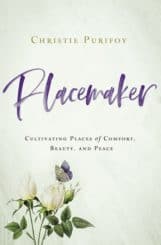
Few places are more lovely than Oregon’s Willamette Valley in springtime. After months of gray skies and persistent cold rain that teeters close to without ever quite becoming snow, a sunny spring day is a celebration. Kids go barefoot, even if the weather still lingers just below 60, and young adults stretch out on blankets in the sunshine, as if lounging at a much warmer beach. We are all glad to have endured one more winter, and rejoice that the best months in Oregon—perhaps our reward for surviving the worst—are just around the corner.
This year, in that liminal space between winter and spring, between darkness and light, I was reading Christie Purifoy’s beautiful new book, Placemaker: Cultivating Places of Comfort, Beauty, and Peace, which calls on us to attend to the places in our lives, consider our own deepest God-created longing for beauty and goodness, and consider what brings us joy and sorrow in the locations—whether literal or figurative—we call home.
As I read Purifoy’s book, I was challenged to see the Willamette Valley, where I’ve lived for over half my life, through a different lens. I have always enjoyed springtime in Oregon, but in describing the rich attentive love she has for her own homestead, Purifoy helped me look more closely at Oregon in spring: at the small buds on cherry trees, forming and then unfolding over the course of several weeks; at the ways a tree-lined street in town began to build its summer canopy; at the daffodils and then tulips that recently started blooming, petal by petal. As I tried to attend to—and rejoice in—each new sign of spring, I felt the entire season opening up before me. I even tried exclaiming with joy at these discoveries, though to be honest, I wonder if my running partner grew tired of me stopping to point out a new bud or new leaf on a tree.
Placemaker almost begs its readers to look closely at their surroundings, both natural and otherwise. In rich prose, Purifoy describes the places where she and her family have settled, framing her entire reflection on placemaking around the purchase and restoration of a Victorian farm home in southeastern Pennsylvania. This home, called Maplehurst, is set back from the road, at first appearing isolated at the end of a tree-lined drive, but in fact adjacent to a suburban development—offering the Purifoy family (Christie and her husband, and their four children) the fulfillment of a long-held dream to own just such a place.
Purifoy makes clear, though, that even this dream comes with losses and challenges, and this is definitely a strength in her book. Rather than merely a paean to the beauty of land and nature and finding one’s home, Purifoy acknowledges that the places we make can hold within them the tension of fecundity and decay, the memories of sadness and emptiness, intertwined with those of joy and fullness. Placemaker returns again and again to this idea, in both figurative and literal terms—using,for example, the significant (and costly!) pruning of the eponymous maple trees lining her drive to show that even in the loss of beautiful treetops, a new landscape opens up underneath, one shot through with brilliant light.
…the places we make can hold within them the tension of fecundity and decay, the memories of sadness and emptiness, intertwined with those of joy and fullness.
If the journey toward Maplehurst and its restoration is the frame through which Purifoy explores placemaking, then different kinds of plants serve as landmarks along the way. Purifoy titles each chapter with the name of a plant that is indigenous—or, if not indigenous, at least abundant—in the land she is exploring. In a chapter on her time living in Chicago, she reflects on the honey locust trees that populated her neighborhood, in part because of the “long, dusty seedpods they dropped…in late fall.” The honey locusts come to represent for her the place she found and loved in Chicago, as well as the loss she accepted by setting down roots (two moves later) in Maplehurst, where honey locust trees do not grow. Purifoy’s appreciation for botanical science is threaded through these ruminations, and Placemaker offers its readers the delight of learning not only a theology of the land, but also a well-informed and fulsome consideration of the trees, alongside other plants, that help make the places we live distinctly beautiful.
I enjoyed most Purifoy’s chapters on her placemaking in a Chicago, when she lived in a stone apartment building, began her PhD studies, and started to grow her family. The pleasure I found in reading these chapters no doubt reflects my own sense of placemaking, the romantic notions I have about Chicago (where I spent my early childhood) and my fascination about what it must be like to create a home within a multi-storied, turn-of-the-century apartment building. I fear that Purifoy’s time in Chicago did little to alter my romantic notions, given her descriptions of green parks, windows overlooking treetops, old rooms full of history and possibility and relationship.
When Purifoy reflects on the communities that tie her to a place—or the loneliness that accompanies those places we might long to abandon—I found myself again and again surveying my own life as a placemaker, and the people (as much or more than the trees, the land, even the dwellings) who have made my places feel like home. Purifoy’s book calls forth this self-inventory in powerful ways.
Purifoy compelling reflects on the significance of hospitality in the places we make, a kind of hospitality extended not only to those we know and love, but also to those who exist in society’s margins, and who might be displaced because of their race or ethnicity or socioeconomic status or disability.
It might be easy to conclude that place-making is much more about creating a lovely space for our own comfort, a restored Victorian home at Maplehurst becoming some kind of edifice of privilege, just another flipped house in our Fixer-Upper culture. But Purifoy compelling reflects on the significance of hospitality in the places we make, a kind of hospitality extended not only to those we know and love, but also to those who exist in society’s margins, and who might be displaced because of their race or ethnicity or socioeconomic status or disability. Restoring Maplehurst thus serves as a compelling metaphor for the loving, creative work to which we are called. That is, God longs for us to stand in the midst of the world’s messiness and pain, and to envision a redemptive story that transforms our own (and others’) brokenness, just as we might find beautiful potential in an old house needing repair.
Placemaker fits well within the long tradition of America’s nature writers, folks like Wendell Berry and Annie Dillard who ask us to attend closely to the land and its goodness.
…God longs for us to stand in the midst of the world’s messiness and pain, and to envision a redemptive story that transforms our own (and others’) brokenness, just as we might find beautiful potential in an old house needing repair.
And, because any review will never do justice to an author’s rich prose style or to the intricacy of her thoughts, my recommendation is to savor Placemaker, its beautiful language, its challenge to see ourselves as placemakers, replicating the work of our Creator. I will definitely remember Purifoy’s work each spring, when I look out onto the place I love best: this home where I have lived for 20 years, overlooking the Willamette Valley, and where the Dogwood in my front yard is just now coming into bloom.
 Melanie Springer Mock is a Professor of English at George Fox University, Newberg, Oregon. She is also the author or co-author of five books including, most recently, Worthy: Finding Yourself in a World Expecting Someone Else (Herald Press, 2018). Her essays and reviews have appeared in The Nation, Christianity Today, The Chronicle of Higher Education, and Mennonite World Review, among other places.
Melanie Springer Mock is a Professor of English at George Fox University, Newberg, Oregon. She is also the author or co-author of five books including, most recently, Worthy: Finding Yourself in a World Expecting Someone Else (Herald Press, 2018). Her essays and reviews have appeared in The Nation, Christianity Today, The Chronicle of Higher Education, and Mennonite World Review, among other places.

